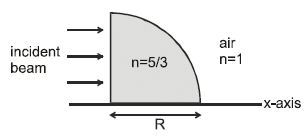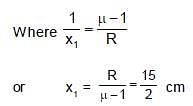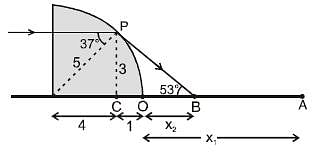NEET Exam > NEET Questions > A uniform, horizontal parallel beam of light ...
Start Learning for Free
A uniform, horizontal parallel beam of light is incident upon a prism as shown. The prism is in the shape of a quarter cylinder, of radius R = 5 cm, and has the index of refraction n = 5/3. The width of the region at which the incident rays after normal incidence on plane surface and subsequent refraction at curved surface intersect on x axis is (Neglect the ray which travels along x-axis as shown in figure)
- a)4 cm
- b)5/4 cm
- c)9/4 cm
- d)25/4cm
Correct answer is option 'D'. Can you explain this answer?
| FREE This question is part of | Download PDF Attempt this Test |
Most Upvoted Answer
A uniform, horizontal parallel beam of light is incident upon a prism ...
The ray just above x-axis shall after refraction at curved surface intersect x axis at (A) a distance x1 from O.


The critical angle for air-glass interface is
 . the rays above the ray incident on curved surface at i = 370 shall suffer TIR and need not be considered.
. the rays above the ray incident on curved surface at i = 370 shall suffer TIR and need not be considered.The ray incident as curved surface at θ= 370 after refraction intersect curved surface at (B) a distance x2 from O.
In Δ PBC

Free Test
FREE
| Start Free Test |
Community Answer
A uniform, horizontal parallel beam of light is incident upon a prism ...
The ray just above x-axis shall after refraction at curved surface intersect x axis at (A) a distance x1 from O.


The critical angle for air-glass interface is
 . the rays above the ray incident on curved surface at i = 370 shall suffer TIR and need not be considered.
. the rays above the ray incident on curved surface at i = 370 shall suffer TIR and need not be considered.The ray incident as curved surface at θ= 370 after refraction intersect curved surface at (B) a distance x2 from O.
In Δ PBC

Attention NEET Students!
To make sure you are not studying endlessly, EduRev has designed NEET study material, with Structured Courses, Videos, & Test Series. Plus get personalized analysis, doubt solving and improvement plans to achieve a great score in NEET.

|
Explore Courses for NEET exam
|

|
Similar NEET Doubts
A uniform, horizontal parallel beam of light is incident upon a prism as shown. The prism is in the shape of a quarter cylinder, of radius R = 5 cm, and has the index of refraction n = 5/3. The width of the region at which the incident rays after normal incidence on plane surface and subsequent refraction at curved surface intersect on x axis is (Neglect the ray which travels along x-axis as shown in figure)a)4 cmb)5/4 cmc)9/4 cmd)25/4cmCorrect answer is option 'D'. Can you explain this answer?
Question Description
A uniform, horizontal parallel beam of light is incident upon a prism as shown. The prism is in the shape of a quarter cylinder, of radius R = 5 cm, and has the index of refraction n = 5/3. The width of the region at which the incident rays after normal incidence on plane surface and subsequent refraction at curved surface intersect on x axis is (Neglect the ray which travels along x-axis as shown in figure)a)4 cmb)5/4 cmc)9/4 cmd)25/4cmCorrect answer is option 'D'. Can you explain this answer? for NEET 2024 is part of NEET preparation. The Question and answers have been prepared according to the NEET exam syllabus. Information about A uniform, horizontal parallel beam of light is incident upon a prism as shown. The prism is in the shape of a quarter cylinder, of radius R = 5 cm, and has the index of refraction n = 5/3. The width of the region at which the incident rays after normal incidence on plane surface and subsequent refraction at curved surface intersect on x axis is (Neglect the ray which travels along x-axis as shown in figure)a)4 cmb)5/4 cmc)9/4 cmd)25/4cmCorrect answer is option 'D'. Can you explain this answer? covers all topics & solutions for NEET 2024 Exam. Find important definitions, questions, meanings, examples, exercises and tests below for A uniform, horizontal parallel beam of light is incident upon a prism as shown. The prism is in the shape of a quarter cylinder, of radius R = 5 cm, and has the index of refraction n = 5/3. The width of the region at which the incident rays after normal incidence on plane surface and subsequent refraction at curved surface intersect on x axis is (Neglect the ray which travels along x-axis as shown in figure)a)4 cmb)5/4 cmc)9/4 cmd)25/4cmCorrect answer is option 'D'. Can you explain this answer?.
A uniform, horizontal parallel beam of light is incident upon a prism as shown. The prism is in the shape of a quarter cylinder, of radius R = 5 cm, and has the index of refraction n = 5/3. The width of the region at which the incident rays after normal incidence on plane surface and subsequent refraction at curved surface intersect on x axis is (Neglect the ray which travels along x-axis as shown in figure)a)4 cmb)5/4 cmc)9/4 cmd)25/4cmCorrect answer is option 'D'. Can you explain this answer? for NEET 2024 is part of NEET preparation. The Question and answers have been prepared according to the NEET exam syllabus. Information about A uniform, horizontal parallel beam of light is incident upon a prism as shown. The prism is in the shape of a quarter cylinder, of radius R = 5 cm, and has the index of refraction n = 5/3. The width of the region at which the incident rays after normal incidence on plane surface and subsequent refraction at curved surface intersect on x axis is (Neglect the ray which travels along x-axis as shown in figure)a)4 cmb)5/4 cmc)9/4 cmd)25/4cmCorrect answer is option 'D'. Can you explain this answer? covers all topics & solutions for NEET 2024 Exam. Find important definitions, questions, meanings, examples, exercises and tests below for A uniform, horizontal parallel beam of light is incident upon a prism as shown. The prism is in the shape of a quarter cylinder, of radius R = 5 cm, and has the index of refraction n = 5/3. The width of the region at which the incident rays after normal incidence on plane surface and subsequent refraction at curved surface intersect on x axis is (Neglect the ray which travels along x-axis as shown in figure)a)4 cmb)5/4 cmc)9/4 cmd)25/4cmCorrect answer is option 'D'. Can you explain this answer?.
Solutions for A uniform, horizontal parallel beam of light is incident upon a prism as shown. The prism is in the shape of a quarter cylinder, of radius R = 5 cm, and has the index of refraction n = 5/3. The width of the region at which the incident rays after normal incidence on plane surface and subsequent refraction at curved surface intersect on x axis is (Neglect the ray which travels along x-axis as shown in figure)a)4 cmb)5/4 cmc)9/4 cmd)25/4cmCorrect answer is option 'D'. Can you explain this answer? in English & in Hindi are available as part of our courses for NEET.
Download more important topics, notes, lectures and mock test series for NEET Exam by signing up for free.
Here you can find the meaning of A uniform, horizontal parallel beam of light is incident upon a prism as shown. The prism is in the shape of a quarter cylinder, of radius R = 5 cm, and has the index of refraction n = 5/3. The width of the region at which the incident rays after normal incidence on plane surface and subsequent refraction at curved surface intersect on x axis is (Neglect the ray which travels along x-axis as shown in figure)a)4 cmb)5/4 cmc)9/4 cmd)25/4cmCorrect answer is option 'D'. Can you explain this answer? defined & explained in the simplest way possible. Besides giving the explanation of
A uniform, horizontal parallel beam of light is incident upon a prism as shown. The prism is in the shape of a quarter cylinder, of radius R = 5 cm, and has the index of refraction n = 5/3. The width of the region at which the incident rays after normal incidence on plane surface and subsequent refraction at curved surface intersect on x axis is (Neglect the ray which travels along x-axis as shown in figure)a)4 cmb)5/4 cmc)9/4 cmd)25/4cmCorrect answer is option 'D'. Can you explain this answer?, a detailed solution for A uniform, horizontal parallel beam of light is incident upon a prism as shown. The prism is in the shape of a quarter cylinder, of radius R = 5 cm, and has the index of refraction n = 5/3. The width of the region at which the incident rays after normal incidence on plane surface and subsequent refraction at curved surface intersect on x axis is (Neglect the ray which travels along x-axis as shown in figure)a)4 cmb)5/4 cmc)9/4 cmd)25/4cmCorrect answer is option 'D'. Can you explain this answer? has been provided alongside types of A uniform, horizontal parallel beam of light is incident upon a prism as shown. The prism is in the shape of a quarter cylinder, of radius R = 5 cm, and has the index of refraction n = 5/3. The width of the region at which the incident rays after normal incidence on plane surface and subsequent refraction at curved surface intersect on x axis is (Neglect the ray which travels along x-axis as shown in figure)a)4 cmb)5/4 cmc)9/4 cmd)25/4cmCorrect answer is option 'D'. Can you explain this answer? theory, EduRev gives you an
ample number of questions to practice A uniform, horizontal parallel beam of light is incident upon a prism as shown. The prism is in the shape of a quarter cylinder, of radius R = 5 cm, and has the index of refraction n = 5/3. The width of the region at which the incident rays after normal incidence on plane surface and subsequent refraction at curved surface intersect on x axis is (Neglect the ray which travels along x-axis as shown in figure)a)4 cmb)5/4 cmc)9/4 cmd)25/4cmCorrect answer is option 'D'. Can you explain this answer? tests, examples and also practice NEET tests.

|
Explore Courses for NEET exam
|

|
Suggested Free Tests
Signup for Free!
Signup to see your scores go up within 7 days! Learn & Practice with 1000+ FREE Notes, Videos & Tests.
























